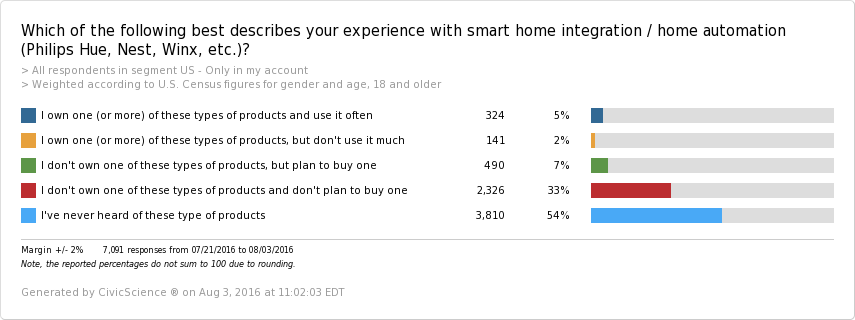Will it ever?
When I was younger, I remember watching the movie Smart House. Basically, a teenage boy wins a competition and his prize is a fully automated house, and over time the house begins to take over.
As a kid, I thought it was so cool and wondered if that technology would ever become a reality (the automated home part, not the computerized house taking over). I figured this technology would be flying off the shelves if it existed. Roughly 15 years later and it is a reality; however, as we found in our recent Insight Report, the smart home trend hasn’t taken off as originally predicted.
According to Business Insider, the U.S. smart home market is in a state of the adoption curve between the early-adopter phase and the mass-market phase. There are still hurdles home automation companies will have to address before achieving mass-market appeal. The prices are high, the ownership periods are long, and there are different networks, standards, and devices being produced, making it difficult for consumers to install and control various devices.
Is this trend close to mass market adoption? Or will it still be a few years before the trend really takes off? CivicScience has been tracking home automation interest since the beginning of 2015 and has an Insight Report on the topic. Let’s find out how consumers feel about smart home products.
When compared to data collected in July 2015, it seems consumers are only slightly more likely to be interested in purchasing a smart device for their home:

The first thing we see is interest level has increased slightly. Those who are not interested in home automation decreased from 57% last summer to 53% this summer. The trend is moving in the right direction, however, over half the population is not interested in purchasing home automation products. And the number of people who are interested isn’t increasing at a high rate year-over-year.
Home security products saw the most change, with more people interested in these products this year than they were last year. This year, 1 in 5 U.S. adults are interested in purchasing home security products.
We can conclude that home automation is interesting to almost half of U.S. adults, and it’s becoming more attractive, but at a slow rate. The data only shows interest in purchasing home automation products, not purchase intent, so let’s move on and look at purchase intent.
Consumers’ ownership plans for smart home devices:

Among U.S. adults, 54% have never heard of smart home products. 7% own a smart home product, and another 7% don’t own a smart home product but plan to buy one soon. This data looks more promising for the home automation industry; if all the “potential buyers” or “persuadable buyers” bought a smart home product, the market would double.
After doing a little digging, we uncovered the demographics, and the technology and shopping insights of current owners and the group of persuadable or potential home automation buyers. (View the full report to see the insights.)
Based on all the data, there’s no doubt that home automation adoption will continue to grow; however, it may be a few years before the trend really takes off.
Right now the market is made up of early adopter homeowners with a higher than average income. People interested in purchasing home automation products look very similar to owners, which means the products aren’t quite at the mass-market phase some companies are hoping for.
But, it’s looking positive for smart home brands; potential buyers’ habits and behaviors are starting to move and align more closely with the general population. There are two major factors to keep in mind:
- 40% of potential buyers don’t own a home yet. We know that many of these individuals will buy a home before investing in home automation, which may be a few years.
- When the time comes that they do purchase home automation devices, we can expect to see a major uptick in awareness and purchases since 62% of persuadables tell family and friends when they are happy with a product. This group will be able to spread the word about the products, which probably isn’t happening as much right now.
Bottom line – the next wave of consumers could be very valuable to the home automation industry. It’s time for home automation companies to focus on fixing and alleviating the barriers to entry. They won’t want to disappoint the next wave of vocal buyers.
View the full report for more details.








